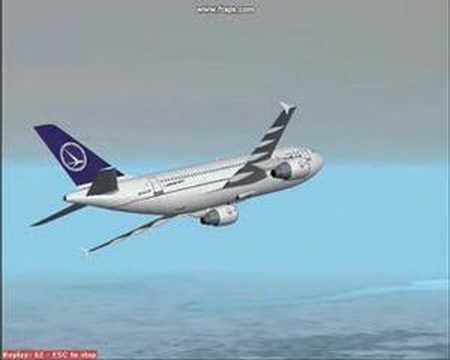Survivors 0 Survivor 0 Crew count 10 | Passengers 50 Aircraft type Airbus A310-324 Date 31 March 1995 Fatalities 60 (all) Passenger count 50 | |
 | ||
Summary Mechanical failure followed by pilot error Similar Aviateca Flight 901, Intercontinental de Aviación, Azerbaijan Airlines Flight 56, 1995 Borodianka mid‑air co, Cameroon Airlines Flight 3701 | ||
Fs 2002 tarom flight 371 crash
TAROM Flight 371 (RO371/ROT371) was a scheduled international passenger flight, flying with an Airbus A310 from Otopeni International Airport in Romania's capital Bucharest to Brussels Airport in Brussels, Belgium. The flight was operated by TAROM, the flag carrier of Romania. On 31 March 1995 the Airbus A310-324, registered as YR-LCC, stalled after take off and crashed near Baloteşti in Romania. All 60 people aboard were killed in the crash.
Contents
Investigation on the crash revealed that the throttle of the starboard engine jammed in-flight. The crew later failed to respond properly to the failure. This combination then led to the aircraft crashing. The investigative committee then concluded that mechanical failure followed by pilot error as the cause of the crash.The crash was the deadliest plane crash in Romania's history. It was also the deadliest plane crash in TAROM's operational history.
Flight
TAROM Flight 371 took off at 08:06 local time (06:06 UTC) and was piloted by 48-year-old Captain Liviu Batanoiu and 51-year-old First Officer Ionel Stoi. The pilot handling the aircraft was First Officer Ionel Stoi. After Flight 371 crossed the altitude of 2.000 ft, a thrust asymmetry occurred on the left engine of the Airbus A310. The crew then noticed the anomaly. First Officer Ionel then asked Captain Liviu to retract the flaps and slats. Captain Liviu then retracted the flaps, however he didn't retract the slats. The speed of the aircraft began to decrease and the aircraft banked to the left.
At 08:08 local time, the engine thrust asymmetry reached almost the maximum value on the EPRs. The aircraft began to bank severely to the left with an angle of 43 degree. The Flight Data Recorder recorded an attempt to engage the autopilot no. 1. Then, a continuous thrust reduction on engine no. 2 was noted. The autopilot then disengaged by the crew and the aircraft began to lose altitude rapidly. Flight 371 began to dive to the ground. The aircraft rolled with the airspeed increasing. First Officer Ionel then cried out "That one has failed!". At the time, the aircraft was nose diving with a pitch angle of 61 degree. The aircraft then crashed onto the ground near Balotesti with a speed of 324 knots.
Bucharest Tower then frantically tried to contact Flight 371, but with no avail. Bucharest Tower then asked another aircraft flying in the vicinity to contact Flight 371. TAROM dispatcher was also asked to contact Flight 371. Knowing that Flight 371 had lost all contact, Bucharest Tower issued a DESTRESFA on the flight. Search and rescue team were assembled by authorities and later found the crash site. The aircraft was pulverized on impact. The impact left a 6 meters deep crater on the field. No survivors were found. All 60 people aboard were killed instantly on impact.
Aircraft
The aircraft involved in the crash was an Airbus A310-324 registered as YR-LCC. The aircraft has an MSN number of 450 and had its first flight in 1987. It was powered by two Pratt and Whitney Canada engines and had logged in 31.092 flight hours and 6.216 cycle. Its airworthiness was issued on 13 April 1994.
Passengers and crew
The aircraft was carrying 49 passengers and 11 crew members. 32 of the passengers were from Belgium, 10 from Romania, three from the United States, two from Spain, one from France, one from Taiwan, one from the United Kingdom, and one from the Netherlands.
The Captain of the flight was 48 year old Captain Liviu Batanoiu. Captain Liviu had a total flying hours of 14.312 hours with 1.735 on the Airbus A310. He graduated from the Aurel Vlaicu Military Aviation School in 1969. Before the flight to Brussels, he had assigned for a Bucharest - Tel Aviv flight. The last training on the type was on 12 November 1994 in a Swissair facility in Zurich, Switzerland.
The First Officer was 51-year-old First Officer Ionel Stoi. First Officer Ionel had a total flying hours of 8.988 hours with 650 hours of them were on the Airbus A310. He graduated from the Aurel Vlaicu Military Aviation School in 1968. Before the flight to Brussels, he had assigned for a Chicago - Shannon flight. The last simulator training on the type was on 21 September 1994, carried out at a Swissair facility in Zurich, Switzerland.
Investigation
Investigators found out that there was a problem with the aircraft's engine. During their examination on the aircraft's logbook, they discovered that during the aircraft climb after take off, engine no. 1 may go back to idle profile when switching to climb power from take-off. The reason was unknown. After several maintenance action took by ground crews, the malfunction never occurred again until 16 March 1995. However, the ground crew warned about the possible re-occurrence of the malfunction. From the aircraft history record obtained from the FAA, similar malfunction had been reported during its operation with Delta Airlines. Delta performed the same actions that TAROM did.
Airbus Industrie was aware of the automatic throttle system (ATS) malfunction. This defect could cause either the jamming of both throttles and ATS disconnection, or one throttle moving to idle while the other remained above climb power, without ATS disconnection. Investigators stated that the most probable cause of this malfunction was due to the excessive friction in the cinematic linkages between the throttle and the ATS coupling units. At the time of the accident, the Flight Crew Operating Manual (FCOM) issued by Airbus Industrie didn't include the procedures to cope with the anomaly. However, it did on the FCOM issued by TAROM and Swissair.
